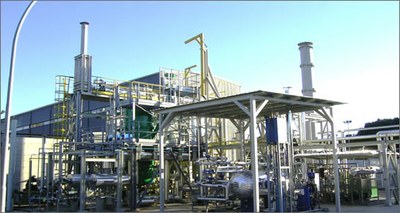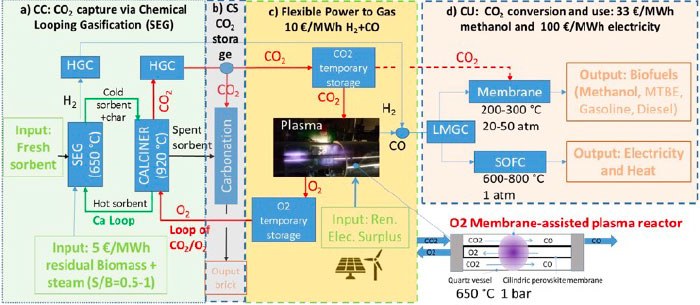Energy: Green hydrogen, 4 million euro EU project for next generation renewables kicks off
15/7/2021
 Producing green hydrogen from biomass and waste while capturing the CO2 emitted for its energy enhancement is one of the objectives of the Italian-led European project GICO[1] coordinated by the Guglielmo Marconi University and including ENEA among its scientific partners.
Producing green hydrogen from biomass and waste while capturing the CO2 emitted for its energy enhancement is one of the objectives of the Italian-led European project GICO[1] coordinated by the Guglielmo Marconi University and including ENEA among its scientific partners.
Funded by the program Horizon 2020 with approximately 4 million euro, the project aims at developing the next generation of renewable energy technologies which will be the 'backbone' of the energy system by 2030 and 2050.
ENEA will conduct experimental activities for green hydrogen production from biomass gasification, with CO2 capture using solid sorbents. Small and medium-sized residual biomass plants (500 - 5,000 kWe), employing 2 to 20 tons of waste per day available locally, will be developed, adopting an approach of sustainable and circular use of resources. "We will be able to convert waste, or waste to be disposed of, into an energy resource with an economic and environmental value", pointed out Donatella Barisano, ENEA researcher at the Laboratory of Thermochemical Processes for Biomass Enhancement, Residues and Waste.
The researchers will also deal with the energy enhancement of the captured carbon dioxide, employing highly innovative reactors in which CO2 is dissociated into carbon monoxide (CO) and oxygen (O2) by means of an ionized gas (cold plasma ). In order to achieve these objectives, ENEA will deploy its research infrastructure ZECOMIX [2] of the ENEA Casaccia Research Center (Lazio) and those of the Trisaia Research Center(Basilicata), particularly the gasification plants, the plasma torch and the analytical laboratories, where the researchers (in the first phase of the project), will characterize and test different types of waste and residues, selected from those considered to be of greatest interest and potential for use.
Both research centers will study the best process conditions to obtain the maximum yield of green hydrogen from residual biomass and biogenic waste fractions (wood, paper and organic waste, employing a prototype fluidized bed gasification plant (Trisaia Research Center) and a rotating drum (Casaccia Research Center) in the presence of specific sorbents for CO2 capture[3].
By adding the sorbents directly into the reactor, during the gasification phase a gas stream with a high hydrogen content and a reduced level of contaminants will be obtained. Finally, the possibility for a further improvement of the quality of the gas produced downstream of the process, will be investigated through a plasma purification system which, employing ionized gases, acts on the residual contaminants.
The following step will concern the experimentation for CO2 valorisation in renewable fuels. Thanks to a cold plasma reactor powered by surpluses of renewable electricity, at the Casaccia Research Center (Rome), the captured carbon dioxide (CO2) will be dissociated into carbon monoxide (CO) and oxygen (O2), promoting its enhancement as a renewable electric fuel (electro-fuel). The carbon monoxide thus produced, combined with green hydrogen from biomass, can be used in solid oxide fuel cells (SOFC) for the production of electricity, or sent to a chemical section for its conversion into liquid biofuels (methanol, petrol or diesel).
The approach proposed by the project GICO allows to close the carbon cycle without increasing global net emissions of CO2 which, although produced, not only does not contribute to increasing climate-altering emissions, but on the contrary, being valorized as a renewable electro-fuel, could make the production of green hydrogen from biomass economically viable, favoring its diffusion in sectors with high carbon emissions like steel, cement and petrochemicals.
"CO2 could become a cornerstone of the energy transition, on which to build a carbon economy in accordance with the principles of circularity - carbon reduction, removal, reuse and recycling – wth the adoption of neutral technologies and technologies with potentially negative impacts", concluded Stefano Stendardo, ENEA researcher at the Laboratory of Engineering of Processes and Systems for Energy Decarbonisation.
In addition to ENEA and University Guglielmo Marconi, the GICO project includes partners active in the fields of basic research (University of L'Aquila, Eindhoven University of Technology), applied research (Csic, Tecnalia, Forschungszentrum Jülich) and the industrial sector ( Iris srl, Ici Caldaie, Calida, Marion Technologies).

For more information please contact:
Stefano Stendardo (stefano.stendardo@enea.it)
Donatella Barisano (donatella.barisano@enea.it)
Project website: https://www.gicoproject.eu/
CORDIS: https://cordis.europa.eu/project/id/101006656
[1] GICO - Gasification Integrated with Carbon capture and cOnversion
[2] ERIC ECCSEL ZECOMIX - Zero Emission of Carbon with MIXed technologies
[3] In the fluidized bed biomass particles are dispersed in a sandy phase held in turbulence by a gaseous stream, while in the rotating drum they pass through a rotating chamber around their longitudinal axis that puts them in contact with water vapor.
